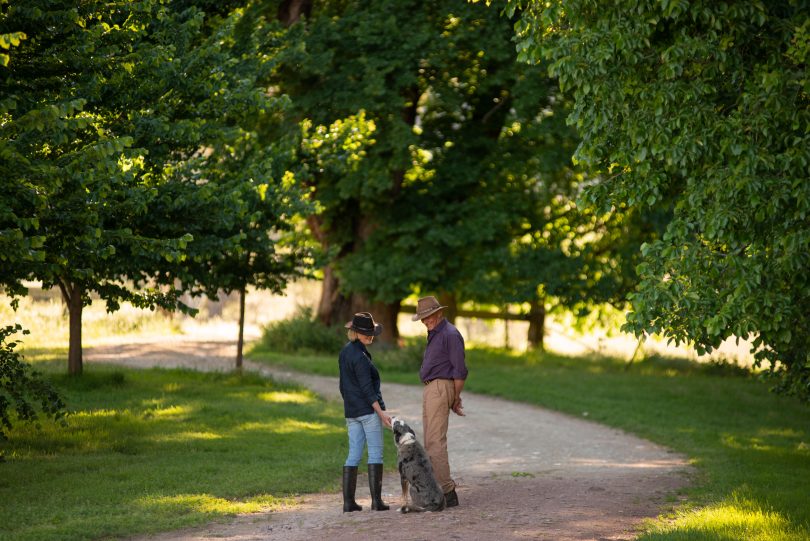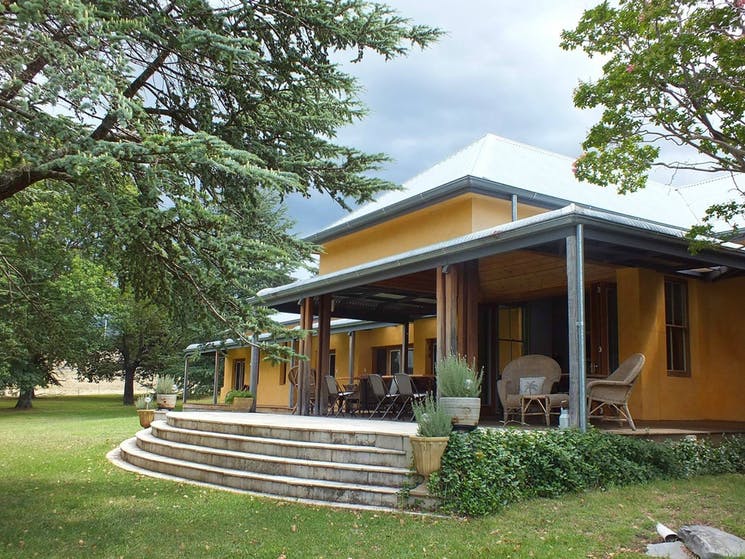
Helen and Ian Cathles of Cooradigbee with their dog Frank. Their historic Wee Jasper homestead is now looking for a new owner. Photo: Rob Little.
It’s believed to be the oldest homestead in the Wee Jasper Valley and has been a haven for Ian and Helen Cathles – for Ian since he was about a year old and more than 40 years for Helen.
It’s also one of the most beautiful in the Yass Valley with its rammed earth walls, wide verandas all around and is, according to Helen, one of the happiest of houses.
After a lifetime there, the Cathles have put Cooradigbee on the market – the five-bedroom homestead with 40 hectares of adjacent land.

Cooradigbee is believed to be the oldest homestead in the Wee Jasper Valley. Photo: Supplied.
“It’s quite a tug for us to sell it,” Helen said. “Ian’s family has always been here. It’s always been the place where our family has got together; we’ve had a lot of reunions here. For as long as I can remember, it’s always been a great place for people to gather.
“There is something about this place that has the most sensational feel about it. It’s always been a very peaceful, happy house.”
Cooradigbee, which is on Ngunnawal land, has been a fine wool property for as long as anyone can remember, but the Cathles have also run angora goats and cattle on it.
Although built in 1910, Cooradigbee’s European history goes back to 1831 when William Dutton took it up as a grant, seven years after Hume and Hovell walked through the valley.
Dutton worked for the Australian Agricultural Company, choosing their sheep, and eventually brought the Saxon variety to the colony in 1826. But after the flock was struck down by disease, Dutton moved on, selling the property to Colin McDonald who stayed there until 1860 when the Barber family took it over. At the time, Samuel Barber was one of the wealthiest landowners in NSW, taking on Cooradigbee in 1866.
Four generations of the Barber family were to live and work on Cooradigbee right up till the 1970s. Although continuing with tradition by running sheep, they also experimented with other crops, successfully growing oranges and corn, as reported in the Goulburn Herald of 1873. One of the original orange trees, planted by family governess Miss Ashton, continues to produce juicy fruit to this day.
The original Cooradigbee homestead was built by Henry Barber in 1910 when he married Alice Graham. It was built at the junction of the Goodradigbee and Murrumbidgee Rivers. As it would have gone under with the construction of the adjacent Burrunjuck Dam, it was moved to higher, drier ground.
The Cathles spent three years restoring the homestead from 2000, ensuring that its stone foundations, 18-inch thick rammed walls and high Baltic pine ceilings would continue to stand the test of time.
“We wanted to maintain its authenticity but also to bring in some modern touches,” Helen said.

Historic Cooradigbee Homestead at Wee Jasper, built in 1910, has been lovingly restored by the Cathles family. Photo: Visit NSW
They also extended the homestead, adding a breezeway, four bedrooms with ensuites and the extensive wide veranda around the whole house. There are five fireplaces in three rooms, a commercial kitchen and an office.
It is also home to some equally historic trees, including 100-year-old elms and spruces.
To the west of the homestead, the young dairy boys’ cottage has also been restored, with the original brick fireplace maintained and turned into a games room.
There is also a gravity-fed 120,000-litre water tank for the house.
Although it’s had many reinventions over the years, Cooradigbee has remained a haven – not only for the Cathles family but for the many visitors who have experienced it as a unique getaway.

Cooradigbee has remained a haven for many. Photo: Supplied.
It is being offered for sale as a family home, although it has been used as farm stay accommodation and a venue for everything from weddings to corporate events.
“There’s something about this place,” Helen said, “that when you’re sitting out under the trees, it’s like feeding your soul.”
Cooradigbee homestead will be going to tender through Butt Livestock and Property Yass and Meares and Associates.
More information is available here.
Original Article published by Sally Hopman on About Regional.








